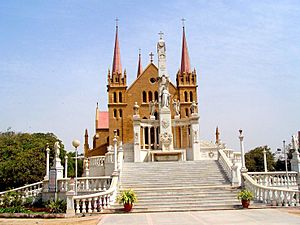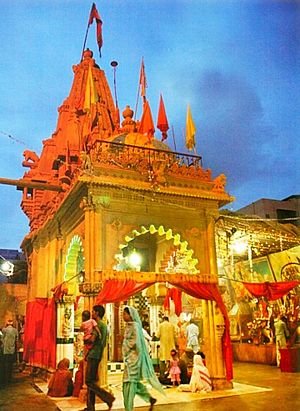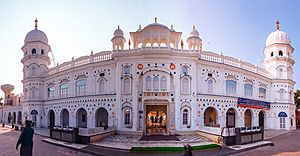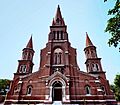Religions of Pakistan facts for kids

Pakistan is a country where many different religions are followed. These beliefs and practices have played a big part in Pakistan's culture throughout history. Long ago, in the area that is now Pakistan (known as the Indus Valley Civilization), important religions like Hinduism and Sikhism began. Also, certain types of Buddhism (called Mahayana and Vajrayana) have roots in the ancient Gandhara region of Pakistan.
Today, Islam is the main and official religion in Pakistan. More than 90% of the people in Pakistan are Muslim. Most of them (about 75%) are Sunni Muslims, and about 25% are Shia Muslims. The second largest religion in Pakistan is Hinduism, followed by between 2% and 4% of the population. Christianity is the third largest religion, with about 1.6% of people following it. Most Christians in Pakistan are either Catholic or Protestant.
The Constitution of Pakistan says that people of all faiths and groups have the freedom to practice their religion. Other religions found in Pakistan include Sikhism, Zoroastrianism, Baha'i Faith, Ahmadiyya, Buddhism, and Judaism.
| Religion in Pakistan | ||||
|---|---|---|---|---|
| Religion | Percent | |||
| Sunni Islam | 75% | |||
| Shia Islam | 20% | |||
| Hinduism | 2.1% | |||
| Christianity | 1.3% | |||
| Ahmadiyya | 0.2% | |||
| Others | 0.3% | |||
Contents
Christianity in Pakistan
Christians are the biggest minority group (a smaller group of people within a larger group) in Pakistan. They live in many different parts of the country. Pakistani Christians come from various ethnic backgrounds and speak many languages. You can find many different kinds of churches in most cities across Pakistan.
Pakistani Christians work in many different jobs. Historically, they have done a lot of important work in health care, education, railways, and the police force. More recently, they are also starting to work in government and military jobs.
Hinduism in Pakistan
Hindus are the second largest minority group in Pakistan.
Many of these Hindus are descendants of people who followed the Hindu religion when Pakistan and India were one country. In those days, some of them were part of the lowest social group in a system called the "caste system." In this system, people were born into different groups that were seen as more or less important. The lowest group was sometimes called "untouchable" and often had to do jobs that others did not want to do.
Today, the law in Pakistan says that no one should be treated badly because of their caste. However, some people still face challenges and often have jobs that do not pay much. But now, more people from these groups are going to school and getting better jobs.
Most Hindus in Pakistan live in Sindh, where many of them are involved in farming. In bigger cities like Karachi, Hindus often work in buying and selling goods. They celebrate their holy Hindu days with all their traditional colors and joy.
Ahmadiyya in Pakistan
The Ahmadis follow the teachings of Mirza Ghulam Ahmad, who lived in the late 1800s. Their religious beliefs are very similar to Islam in many ways. However, Ahmadis do not believe that Prophet Mohammad was God's last Prophet.
Ahmadis consider themselves Muslims. But in Pakistan, a law was passed in 1973 that declared them non-Muslims.
Most Ahmadis are from the Punjabi region (which is in both India and Pakistan). They do a lot of helpful work for people (called humanitarian work) not just in Pakistan, but all over the world.
Zoroastrianism in Pakistan
The Parsis, or Zoroastrians, are a very small minority group in Pakistan. Most of them live in the larger cities. Almost all Parsis work in business. Some of Pakistan's most successful shipping business owners are Parsis. The wealthier members of this community are known for their philanthropic activities, which means they give money to people or organizations to help them or do good things.
Buddhism in Pakistan
There are very few Buddhists living in Pakistan today. However, the ancestors of Buddhists had a big impact on Pakistan's culture long ago. Many ancient Buddhist temples, schools, and cities have been discovered by archaeologists in Pakistan.
Images for kids
-
The shrine of Lal Shahbaz Qalandar
-
The Faisal Mosque in Islamabad, which is the largest mosque of Pakistan and is also one of the largest in the world, was built by King Faisal of Saudi Arabia.
-
Yadgar Mosque, the first mosque of Rabwah
-
Nankana Sahib Gurdwara in Punjab, Pakistan is a famous pilgrimage site for Sikhs
-
Bai Virbaiji Soparivala Parsi School, Karachi














